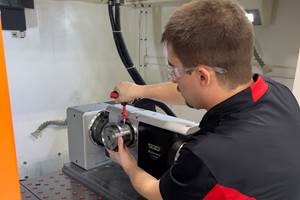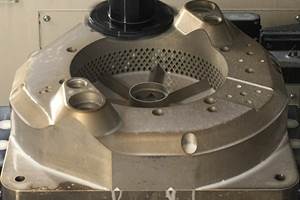Vertical Machining Center Reduces Cycle Time By 84 Percent
A certified subcontractor to Xerox, Space Labs, Barry Controls, ITT, Pacific Scientific, and Air Bus Industries, this shop's parts aren't required to be inspected. Parts are shipped directly from the job shop to the customer's production line.
World Class Manufacturing of Canoga Park, California, found its Haas Automation VF-4 machining center and fourth axis rotary table from Haas Automation, Chatsworth, California, to be a very profitable combination. A certified subcontractor to Xerox, Space Labs, Barry Controls, ITT, Pacific Scientific, and Air Bus Industries, World Class Manufacturing's parts aren't required to be inspected. Parts are shipped directly from the job shop to the customer's production line.
The company was founded in 1975 as National Machine. Split into two companies in 1994, the job shop operations became World Class Manufacturing. Spearheaded by aerospace veteran George M. Haskins, president and experienced machinist and job shopper Gary Carnan, vice-president, the company provides precision parts on machining centers and lathes and assembly for the medical, commercial and aerospace industries.
"We just received a Pyramid contract from Xerox and needed a machining center that would provide four-axis machining capability on a budget," said Mr. Haskins. "And we needed it fast. The Haas VF-4 with a rotary table was the only VMC we found which met our price/feature test."
The Haas VF-4's travels (50 inches, 20 inches, 25 inches) provide for an extra-large X travel, which makes World Class Manufacturing's rotary table setup possible. The VMC features a 15-hp spindle drive with a two-speed gearbox for higher torque, as well as 20-position automatic toolchanger and Haas-built control, with dual 32-bit processors. The control is Fanuc-compatible and has a program execution speed of up to 1,000 blocks per second.
Haas OneTouch is a control feature that is designed to save setup time. By way of example, OneTouch power up turns the power on, homes all axes, picks up the No. 1 tool and loads it into the spindle so the machine is ready to make chips. Tool length measurement stores offsets for 100 different tools with OneTouch. Work coordinate offsets can be loaded with a OneTouch feature too. And OneTouch power-down automatically homes all axes, picks up the No. 1 tool, loads it into the spindle and powers down.
The Pyramid contract awarded to World Class Manufacturing is for machining a casting used in a high-speed laser-fax copier that Xerox markets worldwide. Because they are a certified Xerox subcontractor, they can machine and assemble parts and ship them directly to the customer's production line.
The rotary table with tailstock was used to maximize output. A two-sided fixture mounted to the rotary table rotates each part into position. The tailstock reduces deflection and chatter that can cause a poor surface finish. Also, the tailstock increases accuracy and reduces wear on the rotary table. A separate fixture is mounted on the rotary table's base, so three different parts can be machined without tearing down the machine.
Since the VF-4 accommodates multiple zero positions, multiple parts can be machined limited only by space on the fixture. The operator can do other operations while the Haas machines run virtually unattended.
The Xerox part is die cast aluminum, which requires milling, drilling and rigid tapping operations to tolerances of ±0.001. Before the VF-4 was purchased, cycle time was 60 minutes with six separate operations, one of them off-line which required that the casting be handled twice. Those six separate operations have been reduced to two setups, the rotary table rotates the casting into position for each of five operations and runs unattended while the second operation is performed off-line.
With the VF-4 and rotary table, two parts are set up side-by-side. Cycle time has been reduced from 60 minutes to ten minutes per casting, which is a reduction of 84 percent. "Our two-part fixturing system is the result of teamwork. Management listening to the operators. Our operators are intimately familiar with the jobs and machines and they constantly come up with ideas to reduce setups and cycle time," said Mr. Carnan. "So when we received a rush order to machine, drill and tap 25 plates from another customer, we didn't have to break into our production run and waste eight hours tearing down and rebuilding the setup. We also saved the time it takes to reprogram the tool offsets and inspection time."
Blind holes are difficult to tap to the bottom, because the geometry of a tap does not allow contact with the side wall to cut the last pitch. For example, a valve body with a blind hole many require as many as three taps to get the thread to the bottom.
"We can thread right to the bottom of the hole. Our programmer decides where the lead-in/lead out begins and ends. Our customer gets higher accuracy and cleaner threads," said Mr. Haskins.
Helical interpolation, a function of the low-cost Haas VF-4, enables the blind hole to be threadmilled with only one tool. The thread mill insert does not have a clearance problem and easily cuts the thread form all the way to the bottom. Also, threadmilling to the bottom of the blind hole reduces the possibility of crashing the tap into the bottom or crushing chips into the bottom.
"Over 12 months, we have machined 31,500 parts with zero piece rejection. Which says to us, that when we combined our quality programmers and operators with the Haas machines, we created a pretty formidable team," said Mr. Haskins.
Related Content
What to Do When Five-Axis Machining Is Off the Table
For Fischer USA, 3+2 machining with a high-precision rotary table adds flexibility without the cost of a full five-axis machine.
Read MoreSMEC America Showcasing Machines' Reliability and Rigidity
SMEC America is running demonstrations on its machines both old and new at its IMTS booth, with engineers on hand to help answer questions.
Read More10 Ways Additive Manufacturing and Machining Go Together and Affect One Another
Forget “additive versus subtractive.” Machining and metal additive manufacturing are interconnected, and enhance the possibilities for one another. Here is a look at just some of the ways additive and machining interrelate right now.
Read More5 Tips for Running a Profitable Aerospace Shop
Aerospace machining is a demanding and competitive sector of manufacturing, but this shop demonstrates five ways to find aerospace success.
Read MoreRead Next
3 Mistakes That Cause CNC Programs to Fail
Despite enhancements to manufacturing technology, there are still issues today that can cause programs to fail. These failures can cause lost time, scrapped parts, damaged machines and even injured operators.
Read MoreThe Cut Scene: The Finer Details of Large-Format Machining
Small details and features can have an outsized impact on large parts, such as Barbco’s collapsible utility drill head.
Read More.jpg;maxWidth=970;quality=90)






.jpg;maxWidth=300;quality=90)


.png;maxWidth=300;quality=90)














